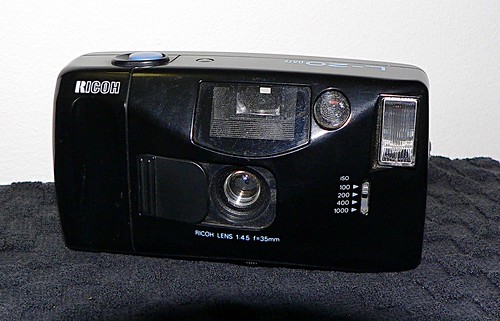Difference between revisions of "Ricoh L-20"
(added photo, rm need photo) |
m (typos) |
||
| Line 15: | Line 15: | ||
| − | == | + | ==Specifications== |
*'''Release Date:''' September 1989 | *'''Release Date:''' September 1989 | ||
| Line 22: | Line 22: | ||
*'''Shutter:''' mechanical, 1/125s fixed speed | *'''Shutter:''' mechanical, 1/125s fixed speed | ||
*'''Film Speed Range:''' manual setting, ISO 100 / 200 / 400 / 1000 | *'''Film Speed Range:''' manual setting, ISO 100 / 200 / 400 / 1000 | ||
| − | *'''Power Source:''' | + | *'''Power Source:''' two AA-type batteries (alkarine or manganese) |
*'''Dimensions:''' 132 mm X 68 mm X 50 mm | *'''Dimensions:''' 132 mm X 68 mm X 50 mm | ||
*'''Weight:''' 230 g (without batteries) | *'''Weight:''' 230 g (without batteries) | ||
Revision as of 17:41, 28 June 2014

|
| Ricoh L-20 Date image by Russell McNeil (Image rights) |
The L-20 is a point-and-shoot camera for 35mm film, introduced by Japanese manufacturer Ricoh in 1989. It is also known as the One Take Easy II. This camera was originally designed to meet the demands from the market in developing countries. A relatively bulky body size for a fixed-focal lens compact, the use of AA-type battery instead of Lithium type, manual film speed rating, these were for that reason. Although its lens is a fixed-focus type, it has a infinity setting facility and can focus on a distant subject by sliding the tiny lever located beneath the lens. A model with a date back was also available and it was sold as the L-20 Date.
Successor Model: Ricoh LX-22 (updated model with the addition of a self-timer)
Specifications
- Release Date: September 1989
- Lens: Ricoh Lens 35mm f/4.5, 3 elements in 3 groups
- Focus: fixed-focus, with infinity setting facility
- Shutter: mechanical, 1/125s fixed speed
- Film Speed Range: manual setting, ISO 100 / 200 / 400 / 1000
- Power Source: two AA-type batteries (alkarine or manganese)
- Dimensions: 132 mm X 68 mm X 50 mm
- Weight: 230 g (without batteries)
Links
- L-20 on Ricoh Official Website, Camera List
- Ricoh L-20 manual at Mike Butkus' site